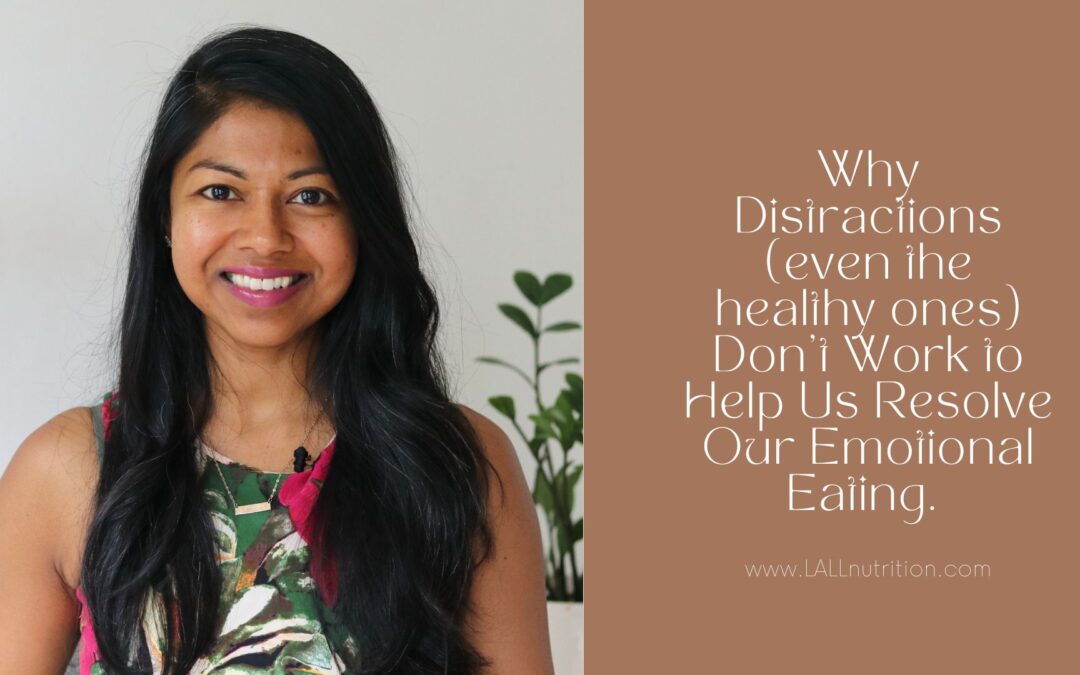Hello love,
Today I want to share with you why distractions (even the healthy ones) don’t work to help us resolve our emotional eating.
I wanted to talk about this because a lot of the times when we are emotional eaters we think we have to do something instead of emotionally eat. We have to go for a walk, take a shower, we need to go see someone.
We *think* having our needs met means we have to do something. That’s what we do as a society whenever uncomfortable emotions come, we distract from it. We “need” to do something. We need to get rid of it right away.
But guess what? That’s what would have happened to have created this emotional eating pattern.
What is Emotional Eating?
Emotional Eating is a coping mechanism and it’s something we would have developed when we were young to distract us from these uncomfortable emotions. We didn’t want to feel it because we didn’t know what to do with it. It was uncomfortable. Our parents and caregivers wouldn’t have modelled how to be with and move through our emotions. They wouldn’t have held that calm space for us to move through it.
So we think something’s wrong with emotions because “they” showed us something was wrong with emotions. Our society as a whole thinks there’s something wrong with emotions.
The moment we feel an emotion and it’s uncomfortable, we want to just do something. We don’t take the time to sit and be with that emotion to hear the information it’s trying to give us. We just want to run away.
I’ve seen this with clients and it’s almost like our mind jumps in and wants us to just figure it out right away. This is not healthy for emotional eating. This actually perpetuates emotional eating because emotional eating in and of itself is a coping mechanism.
It’s a distraction.
Distracting yourself?
So when we are distracting ourselves with food from what’s really going on and then we want to distract from our emotional eating with something else. We’re just replacing one distraction with another.
We’re not actually getting to the root of this pattern. Emotional Eating is multilayered.
When in that moment we can recognize we’re emotionally eating and we jump to do something else, we’re just making that emotion grow bigger because we are ignoring ourselves. We’re avoiding ourselves. We are abandoning ourselves and neglecting ourselves because that’s what would have happened to us in these times of stress.
I know that sounds a little bit harsh, but it is what’s happening in that moment. We keep running away from ourselves. That’s why we’re in this hamster wheel of something’s wrong with me. Because we don’t even understand what emotions are. We don’t understand that the sensations, the discomfort in our body, they’re information and we need to allow them to be, to move through them and to really hear what they’re telling us.
Turning towards yourself
We just need to feel through the discomfort, the sadness, the stress of the day. This is meeting a need of accepting, validating and understanding ourselves. Then from there, we can take an action step.
But when we jump into the action step, we lose whatever’s happening in this moment. We’re jumping to what we *think* we need versus finding out what we truly need.
We’re not turning towards ourselves. This is a big thing that I see with a lot of clients and I was the same way myself. When we’re younger and we’re not mirrored who we are, what we like, what we dislike, we’re not honoured for our emotions. We think something’s wrong with us.
We weren’t told to look within and to honour what our essence was and who we are. So we’re constantly trying to fix ourselves. This doesn’t mean that we don’t need guidance to help us tune back into ourselves, which is the role I play for clients.
It is about being guided back to what we need so we can operate from that place versus from running away. This is something that I see with a lot of us. We avoid emotion, we avoid looking at what’s really going on, we avoid situations, we avoid with people pleasing, we avoid our discomfort. We avoid a lot of things in our life because we don’t know how to look at it. So we run away and because we can’t be with the discomfort.
What’s on the other side of emotional eating?
The thing is, when we’re able to move through our emotional eating pattern, on the other side is our evolution.
We have so much clarity and we know what we actually need. So when we’re in the midst of going to emotional eat, it’s important to know that when you jump out of this and you go for a walk or you take a shower or you call a friend, you’re avoiding yourself because you’re using those things to jump out of you.
If you are with someone that can hold space for you, honours you and can direct you back to yourself and what you need and hold that space, then that’s different than venting.
But what I’ve heard from clients is that when they go to therapy, it’s just a venting session. There’s no resolution. There’s no deep connection. Yes, you get to “offload” whatever emotional charge has built up on the surface, but you don’t get that deep resolution. You get temporary relief.
This is not what we’re looking for. We’re looking for something that’s going to help us drop in.
Deeper integration is needed
There needs to be discernment here. In my own experience, when I was going through my emotional eating, when I was going to therapy, going into that session felt great. I felt good near the end of the session.
But throughout the week, I didn’t know what to do to feel better that moved the needle. The tools that were given to me to change my thoughts or try this strategy or this, it didn’t get into the root. I wasn’t really in my body. I wasn’t being with my emotions, and I wasn’t looking at what was coming up on a deeper level to help me move forward, more powerfully. I was trying to change things with my mind.
I’ve shared this before, but our conscious mind is only 5%. Our subconscious is 95%. This pattern lives in that subconscious area. It’s automatic.
They are now behaviours. And we can’t just use our conscious mind to change it. We have to use a specific way. We have to do this in a specific way where we’re getting into the body and we’re also resolving trauma that created this pattern.
We use emotional eating and food to cope with this unresolved event/trauma. So if that emotion is there and we put emotional eating on top, or we put going for a walk on top or venting to a friend on top, we don’t ever sink into what’s going on under the surface. We don’t ever learn how to regulate our nervous system, how to be with and process and integrate these emotions to find out what our true needs are, to meet our true needs on multiple levels so we can move forward.
This is how we create that unhealthy relationship to food.
Food is a bandaid
Now food becomes this Band Aid and we have this diet mentality around it. We’re trying to get our needs meet by restricting food, by having a certain body, and by maybe being positive or avoiding our emotions. We’re running away from ourselves. Time and time again, we’re running away.
This is why turning back towards yourself, connecting back to food, your body and your emotions is going to help you with this, because you’re no longer distracting.
This is why acceptance is also so important, acceptance in all areas. It doesn’t mean you like or love yourself. It means you’re looking at the reality of what’s going on and that’s where you can start creating true change. When we are critical of ourselves, when we’re negative about ourselves, we’re constantly running away from ourselves to the next best thing that’s going to fix us. This is not how it works.
We need to get into those emotions. We need to get into this pattern, to shift it, to resolve it. We’re sold so many surface solutions and some of these things are simple to do if we don’t have resistance to them. But if we’ve been in this pattern for so long, there’s a lot of resistance.
We need to stop distracting
That first step might not feel amazing to have to stop and be with your emotional eating, but one of my clients said you run away and you avoid for so long that when you turn towards yourself, it’s like a sinking in and it’s real. It *feels* different and you’re no longer trying to avoid.
This is how we can move through. We don’t want to distract from a distraction. We want to get to the root.
So inside of The Emotional Eating Evolution Program, you’re guided through this in three key main areas.
👉🏽Through food, your connection to food. So you’re no longer avoiding food, you’re looking at how you nourish your body with food and you’re not ignoring this and restricting so that you’re triggered into emotional eating.
👉🏽You are looking at your body, its rhythms and rituals and what it needs. So you’re no longer in the shame spiral triggering emotional eating.
👉🏽And then of course, you are being with the emotions that are coming up, actually learning how to be with, process and integrate them, get into the roots of it to meet your true needs, to find out what your true needs are so you can move forward, powerfully. So you’re actually being with and processing these emotions, resolving trauma at a body level. So there’s no avoidance here.
This is about connecting you back to you.
Because when we avoid, we disconnect from ourselves. When we turn towards ourselves, there’s connection and that’s where resolution lies. There is a nuance to all of this, there’s a nuance to connecting to yourself and there’s a nuance to sort of chasing things and avoiding your emotional eating because you think something’s wrong with you. When you look at your emotional eating pattern as a doorway, you turn towards it versus running away from it to the next thing. So if this is resonating for you find out more about The Emotional Eating Evolution Program HERE.
To being with,
Michelle
Certified Holistic Nutritionist Specializing in Emotional Eating


